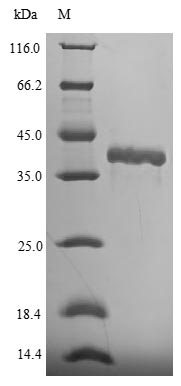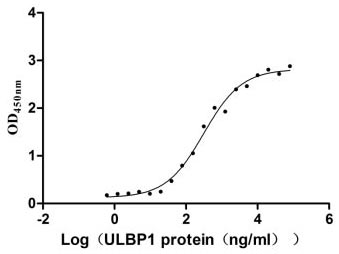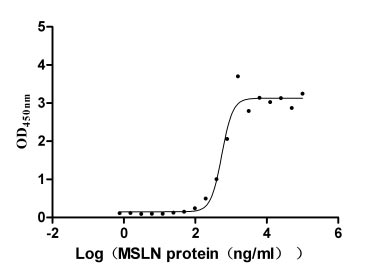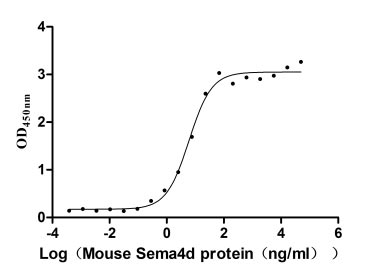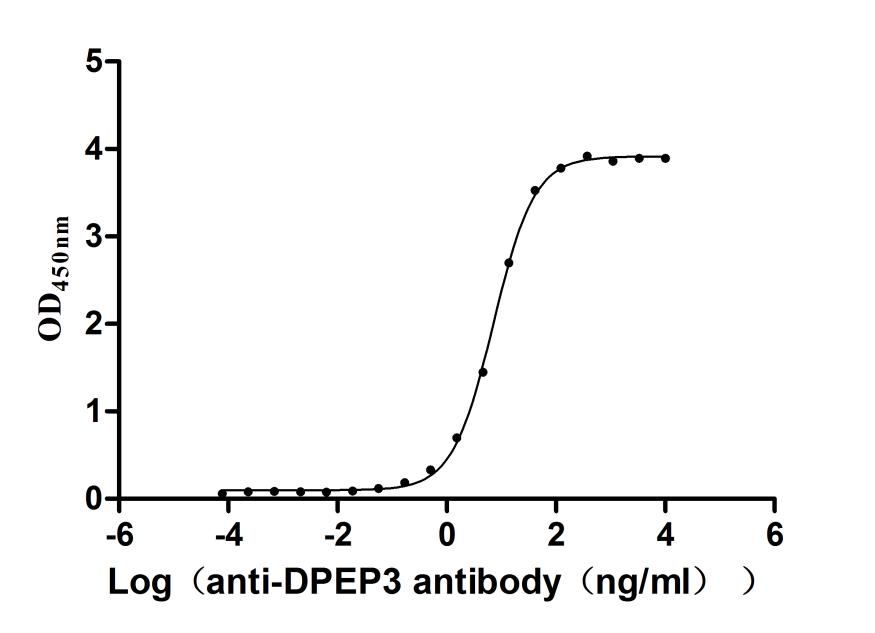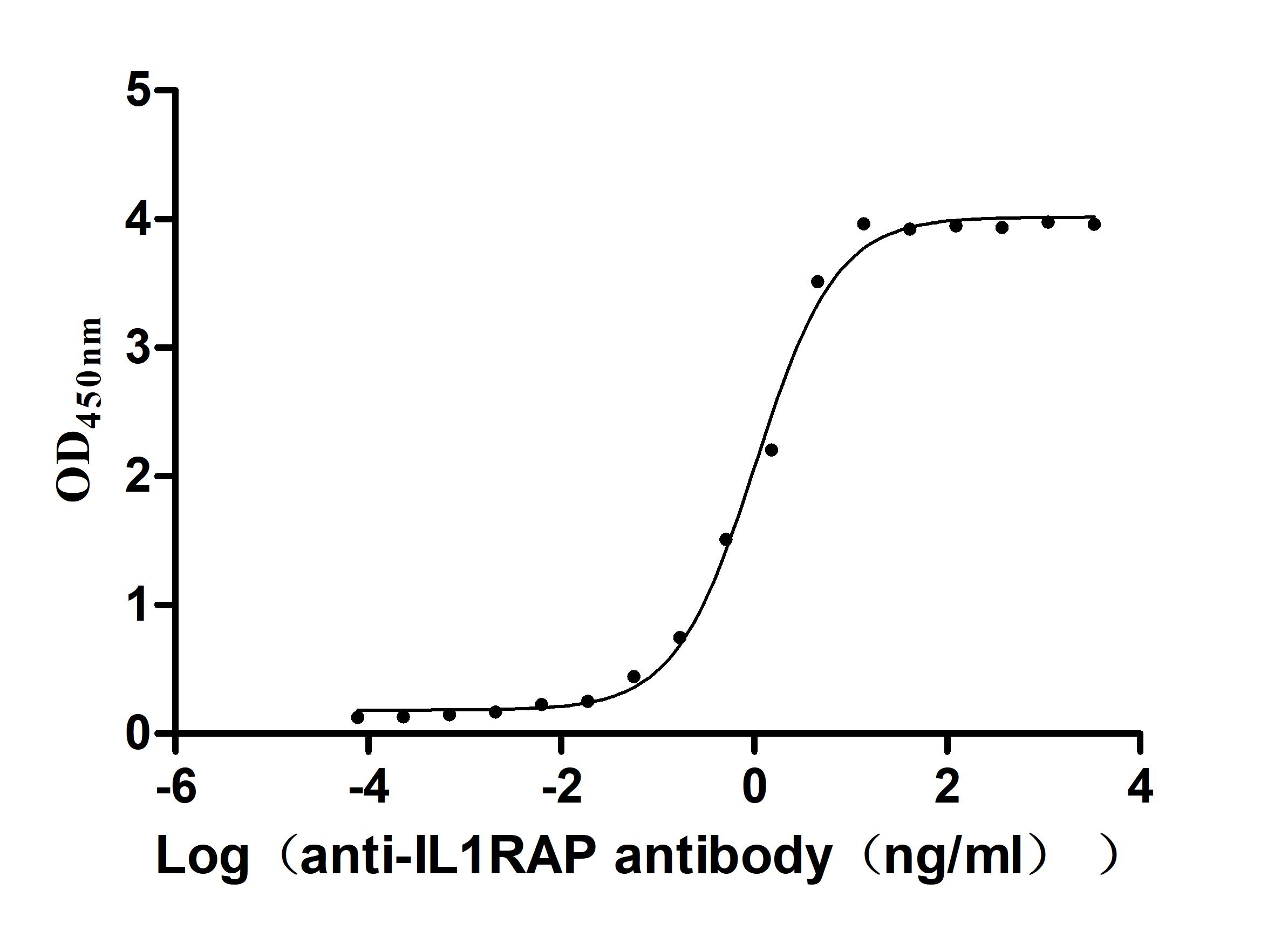Recombinant Mouse Fibroblast growth factor 15 (Fgf15)
In Stock-
货号:CSB-EP522052MO
-
规格:¥1836
-
图片:
-
其他:
产品详情
-
纯度:Greater than 90% as determined by SDS-PAGE.
-
基因名:Fgf15
-
Uniprot No.:
-
别名:FGF-15; Fgf15; FGF15_MOUSE; FGF19; Fibroblast growth factor 15
-
种属:Mus musculus (Mouse)
-
蛋白长度:Full Length of Mature Protein
-
来源:E.coli
-
分子量:38.5kDa
-
表达区域:26-218aa
-
氨基酸序列RPLAQQSQSVSDEDPLFLYGWGKITRLQYLYSAGPYVSNCFLRIRSDGSVDCEEDQNERNLLEFRAVALKTIAIKDVSSVRYLCMSADGKIYGLIRYSEEDCTFREEMDCLGYNQYRSMKHHLHIIFIQAKPREQLQDQKPSNFIPVFHRSFFETGDQLRSKMFSLPLESDSMDPFRMVEDVDHLVKSPSFQK
Note: The complete sequence including tag sequence, target protein sequence and linker sequence could be provided upon request. -
蛋白标签:N-terminal 6xHis-SUMO-tagged
-
产品提供形式:Liquid or Lyophilized powder
Note: We will preferentially ship the format that we have in stock, however, if you have any special requirement for the format, please remark your requirement when placing the order, we will prepare according to your demand. -
缓冲液:Tris-based buffer,50% glycerol
-
储存条件:Store at -20°C/-80°C upon receipt, aliquoting is necessary for mutiple use. Avoid repeated freeze-thaw cycles.
-
保质期:The shelf life is related to many factors, storage state, buffer ingredients, storage temperature and the stability of the protein itself.
Generally, the shelf life of liquid form is 6 months at -20°C/-80°C. The shelf life of lyophilized form is 12 months at -20°C/-80°C. -
货期:3-7 business days
-
注意事项:Repeated freezing and thawing is not recommended. Store working aliquots at 4°C for up to one week.
-
Datasheet & COA:Please contact us to get it.
相关产品
靶点详情
-
功能:Involved in the suppression of bile acid biosynthesis through down-regulation of CYP7A1 expression.
-
基因功能参考文献:
- Taken together, these results suggested that FGF19, through the anti-oxidative defense system, attenuated the development of diabetic cardiomyopathy and restored cardiac function. PMID: 29778534
- ileal FGF15/19 to hepatic FGFR4 axis is activated and promotes liver regeneration (LR) after partial hepatectomy (PH) in mice, supporting the potential of ileal FGF15/19 to hepatic FGFR4 axis-targeted therapy to enhance LR after PH PMID: 29468415
- FRS2alpha-mediated pathways are essential for the FGF15/FGF19-FGFR4 signaling axis to control bile acid homeostasis. PMID: 25056539
- Together, our results show that SuFu promotes cerebellar radial precursor differentiation to neurons. SuFu function is mediated in part by GLI3R and down-regulation of Fgf15 expression. PMID: 28560839
- Results show a reciprocal regulation of adiponectin and FGF19 gene expression in mice. PMID: 27666676
- Tumorigenicity was assessed in three mouse models (db/db, diet-induced obese, and multi-drug resistance 2 [Mdr2]-deficient) following continuous exposure to FGF19 or FGF15 via adeno-associated viral-mediated gene delivery. PMID: 28189755
- These data identify hypothalamic Fgf15 as a regulator of glucagon secretion. PMID: 27829151
- Intestinal sensing of highly elevated levels of conjugated bile acids in blood promotes FGF15 signaling, reducing hepatic bile acid synthesis and modulating bile acid transporters. PMID: 28498614
- Fgf15 is the sonic hedgehog downstream signal to control thalamic regionalization, neurogenesis, and neuronal differentiation by regulating the expression and mutual segregation of neurogenic and proneural regulatory genes. PMID: 26311466
- human microbiota was able to reduce the levels of tauro-beta-muricholic acid and induce expression of FXR target genes Fgf15 and Shp in ileum after long-term colonization. We show that a human microbiota can change BA composition and induce FXR signaling in colonized mice, but the levels of secondary BAs produced are lower than in mice colonized with a mouse microbiota PMID: 27956475
- FGF15 improves lipid homeostasis and reduces bile acid synthesis, but promotes fibrosis during the development of non-alcoholic steatohepatitis PMID: 28673684
- This study demonstrates that the FGF19-SHP-LSD1 axis maintains homeostasis by suppressing unnecessary autophagic breakdown of cellular components, including lipids, under nutrient-rich postprandial conditions. PMID: 28446510
- The elevation in circulating levels of adiponectin and Fgf15 led to normalized hepatic and serum levels of bile acids, limited hepatic accumulation of toxic bile, attenuated inflammation, and amelioration of liver injury in the ethanol-fed mNT knockout mice. PMID: 27573244
- This study reveals SHP as a global transcriptional partner of SREBP-2 in regulation of sterol biosynthetic gene networks and provides a potential mechanism for cholesterol-lowering action of FGF19. PMID: 26634251
- we suggest that considerable mechanistic differences exist between humans and mice with regard to the nuclear receptors controlling the VitA-FGF15/19 axis. PMID: 26723851
- Ileal Fgf15 expression is a potent inhibitor of bile acid synthesis. PMID: 26040986
- Protective effects of farnesoid X receptor on hepatic lipid accumulation are mediated by hepatic FXR and are independent of intestinal FGF15 signaling. PMID: 25156247
- In mice with humanized livers human hepatocytes do not recognize FGF-15 produced by mouse intestine, resulting in up-regulation of bile acid synthesis enlargement of the bile acid pool, affecting the hepatostat. PMID: 26028580
- Intestinal PPARalpha-UDP- Glucuronyltransferases and downstream FXR-FGF15 signalling play vital roles in control of bile acid homeostasis and the pathological development of colitis. PMID: 25183423
- Sstudy shows an important contribution of ileal FGF15 to hepatocarcinogenesis in a clinically relevant mouse model where lack of Fgf15 resulted in reduced tumor burden and attenuated tumor progression. PMID: 25346390
- results suggest that FGF15 deficiency severely impairs liver regeneration in mice after PHx. The underlying mechanism is likely the result of disrupted bile acid homeostasis and impaired priming of hepatocyte proliferation. PMID: 24699334
- a direct role of intestinal FGF15/19 in the regulation of SI P450 expression and may have profound implications for the prediction of drug exposure in patients with compromised hepatic P450 function PMID: 24184963
- findings implicate the brain in the antidiabetic action of systemic FGF19 and establish the brain's capacity to rapidly, potently, and selectively increase insulin-independent glucose disposal PMID: 24084738
- Total ileal FGF15 expression was elevated almost 20-fold in Ostalpha(-/-) mice as a result of increased villus epithelial cell number and ileocyte FGF15 protein expression PMID: 22542490
- generated a variant of FGF19, FGF19-7, that has altered receptor specificity with a strong bias toward FGFR1c PMID: 22457778
- Differential specificity of endocrine FGF19 and FGF21 to FGFR1 and FGFR4 in complex with KLB. PMID: 22442730
- Mouse Fgf15 and human FGF19 play key roles in enterohepatic signaling, regulation of liver bile acid biosynthesis, gallbladder motility and metabolic homeostasis PMID: 22396169
- Pregnane X receptor activation induces FGF19-dependent tumor aggressiveness in humans and mice PMID: 21747170
- mice lacking FGF15 (FGF19) fail to maintain blood concentrations of glucose and normal postprandial liver glycogen; FGF19 activates a physiologically important, insulin-independent endocrine pathway that regulates hepatic protein and glycogen metabolism PMID: 21436455
- Fgf15 is a crucial signaling molecule regulating the postmitotic transition of dorsal neural progenitors and thus the initiation and proper progression of dorsal midbrain neurogenesis in the mouse. PMID: 21172336
- the physiological relevance of the contribution of the intestinal FXR-Fgf15 signalling pathway in control of hepatic bile acid synthesis PMID: 20531290
- the structure-function relationship of FGF19/FGF21 and the structural basis underpinning the distinct proliferative feature of FGF19 compared with FGF21 PMID: 20660733
- activation of FGFR4 is the mechanism whereby FGF19 can increase hepatocyte proliferation and induce hepatocellular carcinoma formation. PMID: 20018895
- Fgf15 is expressed in the optic vesicle, a subset of progenitor cells of neural retina, and emerging ganglion and amacrine cells during retinogenesis PMID: 15465490
- Fgf15 is directly regulated by Shh signaling through Gli proteins in the developing diencephalon and midbrain PMID: 15614767
- in the mouse, loss of FG15 gene function results in high penetrant VSDs and alignment defects of the aorta and pulmonary trunk PMID: 15789410
- fibroblast growth factor 15 (FGF15) signals from intestine to liver to repress the gene encoding cholesterol 7alpha-hydroxylase (CYP7A1), which catalyzes the first and rate-limiting step in the classical bile acid synthetic pathway PMID: 16213224
- identified two enhancers: one directed lacZ expression in the hindbrain/spinal cord and the other in the posterior midbrain (pmb), rhombomere1 (r1) and pharyngeal epithelia PMID: 16930954
- compare the expression pattern during neural development of chick Fgf19 with mouse Fgf15. PMID: 17654705
- These findings suggest that the repressor form of Gli2 preferentially binds to the GliREs to control Fgf15 expression. PMID: 18279667
- FGF15 and FGF8 have distinct signaling properties, and opposite effects on neocortical patterning and differentiation PMID: 18625063
- The results of this study indicate that both beta-Klotho and FGF-15/19 repress the apical sodium-dependent bile acid transporter in enterocytes and cholangiocytes. PMID: 18772362
- FGF15/FGFR4 integrates growth factor signaling with hepatic bile acid metabolism and insulin action PMID: 19237543
- Results suggest that FGF19-regulated liver bile acid metabolism could be independent of its glucose-lowering effect, and direct FGFR activation in adipose tissue may play an important role in the regulation of glucose homeostasis. PMID: 19706524
显示更多
收起更多
-
亚细胞定位:Secreted.
-
蛋白家族:Heparin-binding growth factors family
-
组织特异性:Expressed in the developing brain.
-
数据库链接:
KEGG: mmu:14170
STRING: 10090.ENSMUSP00000033389
UniGene: Mm.3904
Most popular with customers
-
Recombinant Human UL16-binding protein 1 (ULBP1) (Active)
Express system: Mammalian cell
Species: Homo sapiens (Human)
-
Recombinant Human Mucin-16 (MUC16), partial (Active)
Express system: Mammalian cell
Species: Homo sapiens (Human)
-
Recombinant Mouse Semaphorin-4D (Sema4d), partial (Active)
Express system: Mammalian cell
Species: Mus musculus (Mouse)
-
Recombinant Human Dipeptidase 3(DPEP3), partial (Active)
Express system: Mammalian cell
Species: Homo sapiens (Human)
-
Recombinant Macaca fascicularis Interleukin 1 receptor accessory protein(IL1RAP), partial (Active)
Express system: Mammalian cell
Species: Macaca fascicularis (Crab-eating macaque) (Cynomolgus monkey)

